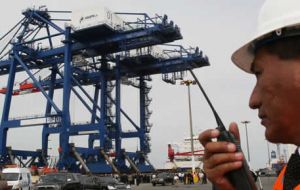MercoPress. South Atlantic News Agency
Uruguay/Argentina summit will address canal dredging and power transmission
 Nueva Palmira is seen as a threatening competitor by Buenos Aires
Nueva Palmira is seen as a threatening competitor by Buenos Aires The dredging of the Uruguay River and access to the Martin Garcia canal as well as importing power from Paraguay are the two main issues of the agenda to be addressed by Presidents Jose Mujica and Cristina Fernandez de Kirchner when they meet Tuesday in Buenos Aires.
Mujica will be travelling with several cabinet ministers and the priority of the bilateral meeting is preparing the bid papers for the dredging of one of the two main River Plate canals, Martin Garcia which leads to Nueva Palmira that has become Uruguay’s leading commodities export terminal.
The other main canal is Mitre, which leads directly to Buenos Aires and is kept in reasonable good conditions for it is essential for maritime traffic in the port of the Argentine capital.
However it is not new that powerful Argentine lobbies linked to the Buenos Aires terminal are not happy with having a very dynamic and efficient (and competitive) Nueva Palmira port just across the River Plate.
President Mujica has repeatedly stated that dredging the Martin Garcia canal is a priority for his administration and has gone to lengths to reach an understanding with the administration of President Cristina Fernandez de Kirchner.
The other main issue for Uruguay and which also depends on Argentina is purchasing 200MW of power per hour from Paraguay. Power from landlocked Paraguay to reach Uruguay must cross through Argentine territory and here again it is a highly sensitive issue for Buenos Aires.
In effect, Paraguay is selling Uruguay power from its totally owned hydroelectric dam of Acaray, but Argentina also is joint owner with Paraguay of another huge dam, Yaciretá, and under contract any surplus power can only be sold to the associate.
Argentina as well as Brazil (that faces a similar situation but with the world’s largest operational hydroelectric dam of Itaipú) insist they want to make sure the power transmitted effectively comes from Acaray and not from Yaciretá, particularly since they will use Argentine transmission lines on Argentine territory.
Paraguay claims that all documents for the implementation of such a deal are ready (and transmission was successfully tested a few weeks ago), but the only signature missing is that of Argentina’s Federal Planning, Public Investment and Services minister Julio De Vido who is also the country’s energy tsar.
Paraguayan sources have also complained that Argentina pretends to charge a toll for the use of power lines above regional prices.
But analysts believe there is a deeper reason because Argentina and Brazil pay for surplus power from Paraguay at rates of several decades ago when the huge dams were built, and the administration of Paraguayan President Fernando Lugo made his campaign slogan recovering “energy sovereignty”.
Selling power to Uruguay at spot market prices, even when the bill won’t be more than 30 million dollars annually, somehow breaks that firm grip of decades from the two powerful neighbours.
Another issue, trade, which both Argentina and Uruguay have anticipated does not figure as an issue in the official bilateral 23 point agenda for Tuesday but is believed it will be addressed because of the growing barriers imposed by Argentina on imports even from Mercosur partners.
Uruguayan exporters have repeatedly requested authorities bring up the issue at Tuesday’s meeting particularly the latest Argentine innovation which demands that Argentine importers must ensure a 1x1 or dollar for dollar policy. This means they must be responsible for selling overseas the same value in dollars which they import be it from Mercosur or from the rest of the world.
“This has begun to be applied to furniture, glass, house materials but tomorrow could be demanded from all sectors”, warns Washington Burghi, Uruguay’s president of the Industries Chamber.
Burghi recalls that Argentina started by bullying Argentine importers not to purchase overseas what was locally produced; then the 60-day non automatic import licences, a time span Argentine Customs does not respect and now the 1x1 policy.
“This in spite of the fact Argentina has a comfortable surplus with Uruguay which last year reached 889 million dollars, 502 million exports and 1.4 bn imports”, pointed out Burghi.




Top Comments
Disclaimer & comment rulesCommenting for this story is now closed.
If you have a Facebook account, become a fan and comment on our Facebook Page!